This is a blog post for you who also have a food blog and want to grow it. In my day job as a management consultant I had the opportunity to create this model for online growth and here I have adapted it to be highly relevant for food bloggers.
The model aims to answer these important questions you as a food blogger have if you are interested to know how to get traffic to your blog, build your email list and build revenue from all that hard work:
- How can we learn more about our future visitors? (ANALYZE)
- How can we reach more of them? (REACH)
- How can we get more people to be interested? (NURTURE)
- How can we get more people to leave their contact info? (NURTURE and CONVERT)
- How can we get more people to buy what we have to offer? (CONVERT)
- How can we get more people to become returning visitors? (DELIGHT)
- How can we get more customers to buy more? (DELIGHT and CONVERT)
- How can we get more people to refer us to a friend? (DELIGHT)
- How can we get more visitors to share, comment, like our content? (DELIGHT)
- How can we enhance our product or service around what actually leads to growth? (ENHANCE)
Many of the ideas come from optimizing growth for SaaS companies, and much inspiration comes from the startup world. And of course inspiration from what other food bloggers have done. I think the best facebook group for inspiration and discussion with fellow food bloggers is the Food Blogger Friends group. Another inspiration specifically for food blogs is The food blogger pro podcast by Bjork Ostrom from Pinch of Yum.
Let us go through the different parts of the model and what is meant by each, including a few examples. I give you the ultimate growth guide for food bloggers:
ANALYZE:
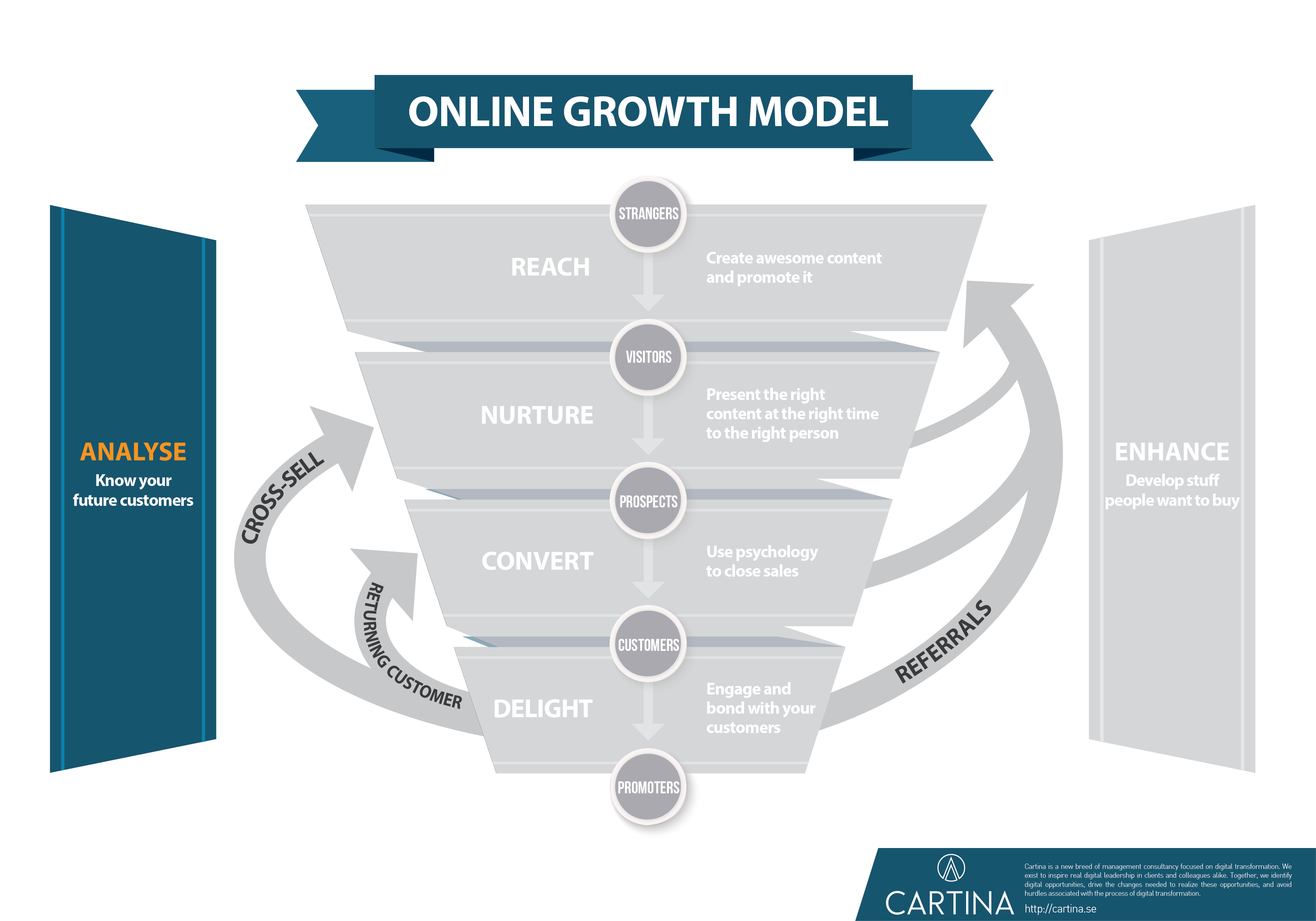
- To work efficiently with growth, you need to understand your most important customer segments by creating marketing personas / avatars and customer journey maps.
- Other work in this step is keyword research and competition analysis to find the most beneficial content to create.
- In addition to the initial work with personas, customer journey maps, keyword research, and so on, you will also need to measure, analyze, and act on it continually.
- Analysis of every activity and the effects will also be needed in every step of this growth model.
Examples of what you can do:
- Do you know who your ideal visitor/reader/customer is? Have you found your niche?
- Do you know which recipe titles or food related searches are most beneficial for you to create content around?
- Do you analyze who the visitors to your blog are and what they do there? using Google analytics or some other tool?
- Do you send out surveys to your email list or ask visitors on your site to answer some simple questions so you learn more about them?
- Do you interview your existing customers (if you have some monetization of your blog in place)
- Do you analyze your existing content to find what can be improved on, what worked and what did not work?
What to include in a Persona (or Avatar):
- Personal goals and challenges
- What food preferences they have
- How their breakfast/lunch/dinner routine looks like
- Search phrases they likely would use
- Watering holes (e.g. other blogs, publications, facebook groups, etc)
- Buying preferences
- Demographics
Read more on how to create personas in this guide
How to do a Customer Journey Map:
- Identify main stages
- Identify touch points & channels
- Describe actions & process
- Describe customer thoughts & goals
- Describe experience & emotions
Read more about Customer journey maps in these two guides:
- All you need to know before customer journey mapping
- A step by step guide to building customer journey maps
REACH:
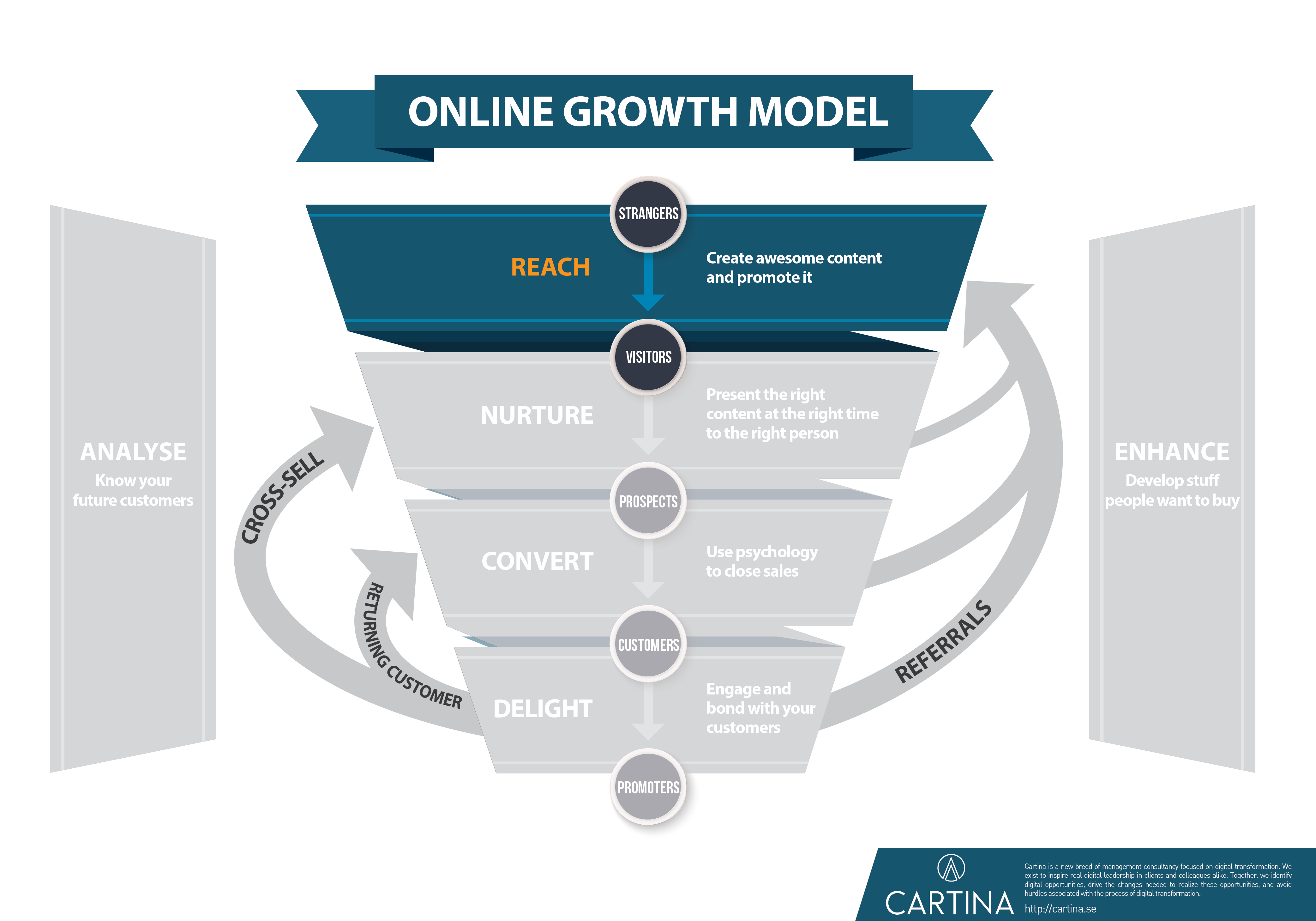
- To grow, you need to reach new potential readers/customers, get their attention, and get them to visit your site or anywhere else you have the possibility of nurturing them to move them closer to becoming customers.
- This step is about creating content that captures attention immediately.
- It is also about finding ways to reach your target groups outside your website with the created content and getting them to want to know more.
Examples of what you can do:
- Here you have tactics such as emailing your previous readers, optimizing SEO, adding your content on social media, etc
- When creating content for your blog, many of you have already understood that amazing photo skills or video skills are really important factors if you want a chance to gain visitors
- There are so many things to do to optimize existing content so it ranks high when searched. And also thinking strategically around creating new content so it is based on keyword research
Food photography tips:
Good quality food photos are the basis of so many more strategies to grow your traffic so you better continue to improve on your skills.
- Lighting is the most important skill to master
- Use natural daylight or lamps with 5000 Kelvin
- Place light from the side or from behind
- Use a reflector to minimizing shadows
- Use a diffusor to avoid too hard lighting and thus sharp shadows
- Switch off any lamps with the wrong color temperature
- Equipment tip is to buy the Lowel ego light for a cheap but good replacement for daylight
- Choose the suitable angle for each. From above, from the side or at an angle. A burger or a stack of pancakes is not that great if you take it from above 😉
- Use props and remove distractions. Surround your main dish with ingredients and props that relate to the food
Read more on the basics in this great introduction with examples or take a course like this free Photography eCourse or the one offered at the Food blogger pro community by Lindsay from Pinch of Yum
Most common channels for getting traffic to your food blog:
- Search
Search and Pinterest are probably the main source of traffic for most food blogs. But in some cases it could be though:
- Recipe submission sites such as Yummly, Foodgawker, etc
- Paid social media
- Roundups
SEO for food bloggers:
SEO is usually one of the most important sources you have for traffic if you have had your food blog for a while. So it’s an area most food bloggers can improve on and gain great results. I have too much information here to include in this blog post so I made a separate blog post about SEO for food bloggers. A lot of time went into that to make it better than everything else you will find when just googling SEO for food bloggers.
Here are some of the sections that are included and that you need to master:
- Setting up your blog for SEO
- on site factors
- off site factors
- optimize for user experience
- optimize content
- Using keyword research to find what you should write about
- Improve on pages you already rank fairly well
- How to optimize a blog post for SEO
- Link building – how to get backlinks
- Build internal links
- Optimizing images
- WordPress plugins
If you prefer another format than my comprehensive blog post on SEO then you can listen to the podcast Optimizing your food blog’s SEO with Casey Markee or check out this SEO for food bloggers ebook from Pickles & Honey
Pinterest tips:
Pinterest and SEO are usually the two most common sources for traffic to a food blog. Therefore it is worth improving on how you work with Pinterest so you can gain more traffic.
- Optimize images for pinterest
- Vertical format works best
- Combine several images and text for best effect, you can use Canva or some other photo editing tool for this
- Optimize title and description for pinterest (think search friendly)
- Also add relevant hashtags
- Join/create group boards
- Apart from enabling you to pin to more boards it also places your pins in front of another audience
- Check out Pin groupie for discovering which boards are most relevant for you, then reach out the the group board creator
- Another way is through the Facebook groups dedicated to Pinterest Group Boards
- Enable rich pins
- First you need to have your recipes in a standardized format. Easiest is to use a plugin for all your recipes and then follow the guide on Pinterest
- Pin to multiple boards
- Use a tool like Tailwind to simplify the process
If you want to learn more I can recommend joining the discussion in this facebook group: Simple Pin Pinterest Strategy Group. And you can also listen to the Simple Pin Podcast by Kate Ahl, especially this episode about Pinterest marketing for food bloggers with Lauren from Six Sisters Stuff
Recipe submission sites:
If you have good quality recipe photos then you should defintely look into submitting them on a few submission sites. Yummly and Foodgawker are the ones that seem to give the most traffic for most food bloggers, but best is if you experiment with a few sites and stick with those that give you result worth the time to submit recipes.
- Yummly
- Foodgawker
- Healthy Aperture
- Tasteologie
Here are some more recipe submission sites
And here’s a guide analyzing pros and cons of the different recipe submission sites
NURTURE:
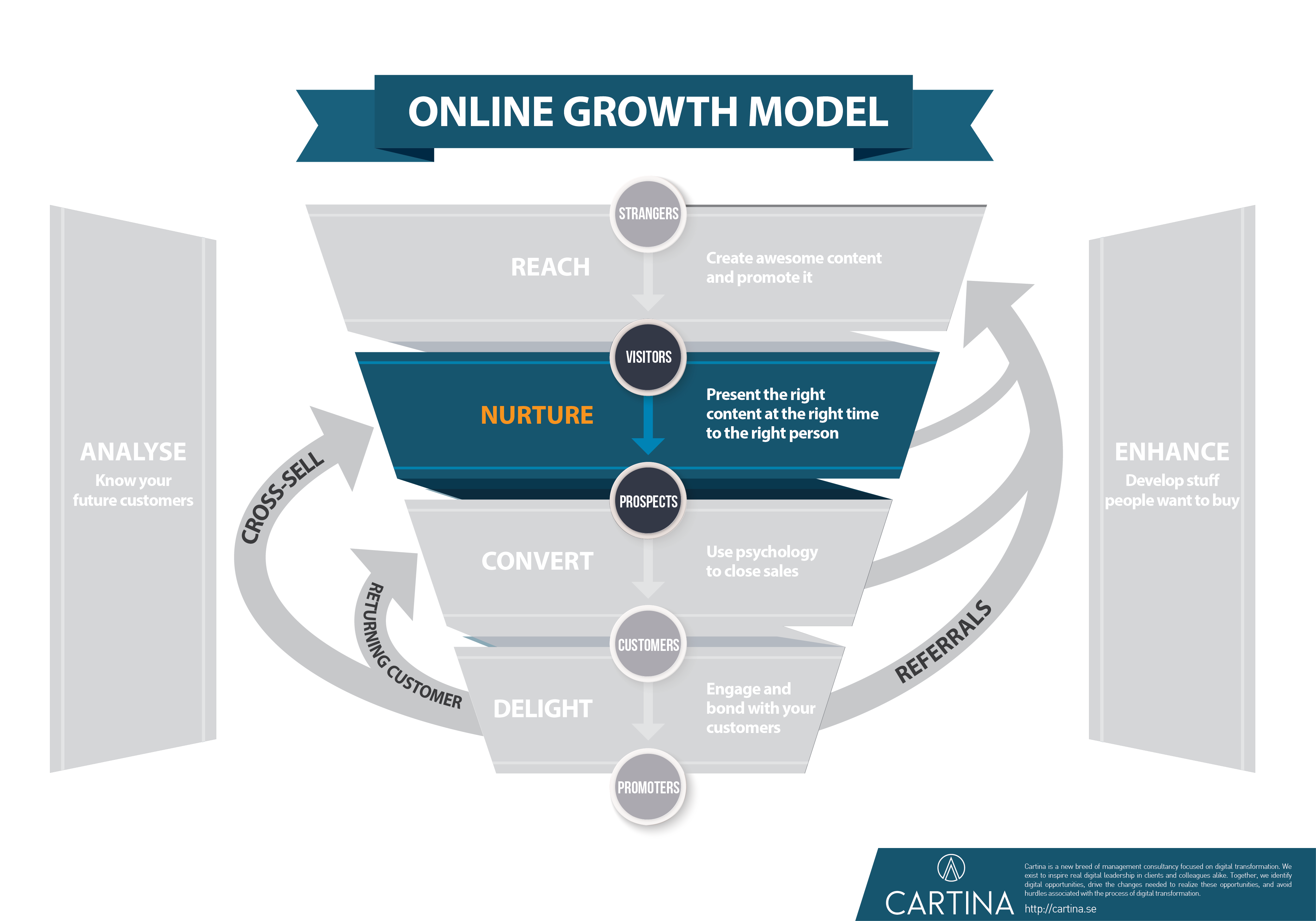
- The start of this phase is to get enough information on the visitor so that you can continue nurturing the relationship.
- Adjust the content of the landing page so that first-time visitors are driven towards continuing to read or leaving their information so that it is possible to nurture them even after they have left your page.
- The goal of this phase is to move a visitor toward becoming a prospect. This goal is mainly achieved through adjusted content delivered at the right time in the right place.
Examples of what you can do:
- The most common way to get information on the visitor so you can reach them again is to get their email adress. It can also be getting them to accept communicating with you on messenger. It could also be to get a pixel/cookie on them so you can use retargeting to reach them later on.
- Every blog post you publish is a potential landing page and you should have a call to action to continue reading and/or some convincing way to get the visitor to leave their contact information. It could be an exclusive ebook they can download if they leave their email. Or a meal plan e.g. “Sign up and get our 7 Day Budget Meal Plan with breakfasts, lunches, and dinners absolutely free!”
- Don’t just add a pop up or section saying “Don’t miss another recipe” or “Subscribe to receive recipes by email”! The conversion of that is extremely low compared to if you offer them something of value right away. Here’s a better example from Delightful Vegans
- Use different kind of ways to get the lead magnet in front of your visitors. Exit intent pop up should be mandatory since you are not interupting their experience while at your site.
- If you have WordPress then here’s my favorite tool for creating nice looking lead magnet forms: Thrive leads
- A “welcome mat” can really increase the conversions, but be careful to make the message and offer be worthy of stuffing it in their face. I think Hot for food did it really nice pushing their new cookbook
- Pushing them to follow you on Pinterest, Instagram or Facebook could be an option, but not as good as getting their email.
- A way of getting the visitor to read more is to offer relevant other recipes at the end of the blog post
- If the visitor is viewing a category of yours then you can show them “the 10 most popular recipes in category x”
Possible lead magnets to offer as a food blogger:
Of course this depends on what nische you have chosen and what you want your visitors to ultimately buy. Your lead magnet is not just a way to collect email adresses, it could also be a qualifier for people that are more likely to buy from you.
- eCookbook
- Video tutorial
- Access to exclusive recipes
- Access to community
- Menu plans
- List of ingredients you always should have at home
- Printable meal calender
- Printable infographics for your kitchen
- Email course
Nurture your contacts:
Once you have got an email adress you can start working on getting that contact warmed up and more ready to “be sold to”.
Of course it depends a lot on what you want your contacts to ultimately do or buy (check out this list of 15 different ways to make money as a food blogger). If you currently don’t have anything to sell, then your goal is probably more to make them a fan that regularly visits your blog and hopefully shares/comments/pins your recipes. If that is the case then you can:
- Set up an email sequence for new subscribers where you first try to learn more about the person and what they like. E.g. ask which food categories they like to subscribe to (and then automatically send them an email when a new recipe is posted)
- Your next email could be to send them your most valuable content and measure what links they click on (and store that info about your contact)
- Your third email could be to send them some great kitchen hacks
- Next you could send the best of your old recipes in relevant categories
- For all the above you can set up reminder emails to go out if they have not opened your previous email.
If you have someting to sell then you can of course use the above sequence as well, but you can add something more in line with what you sell. Let’s say you sell meal plans then you can:
- Start sending an email describing the common problem on what to eat for dinner every day, and perhaps add your list of must have ingredients that help the person have more options to cook.
- Or you can provide them with a printable template so they can start meal planning themselves.
- Then you can send them some great tips for how to get started with meal planning.
- You can ask them what type of recipes they want to eat for dinner (e.g. vegetarian, healthy, quick, etc)
- Once a person have passed through this sequence you will have learned more about them and they are more likely to accept an offer to buy your meal planning service
CONVERT:
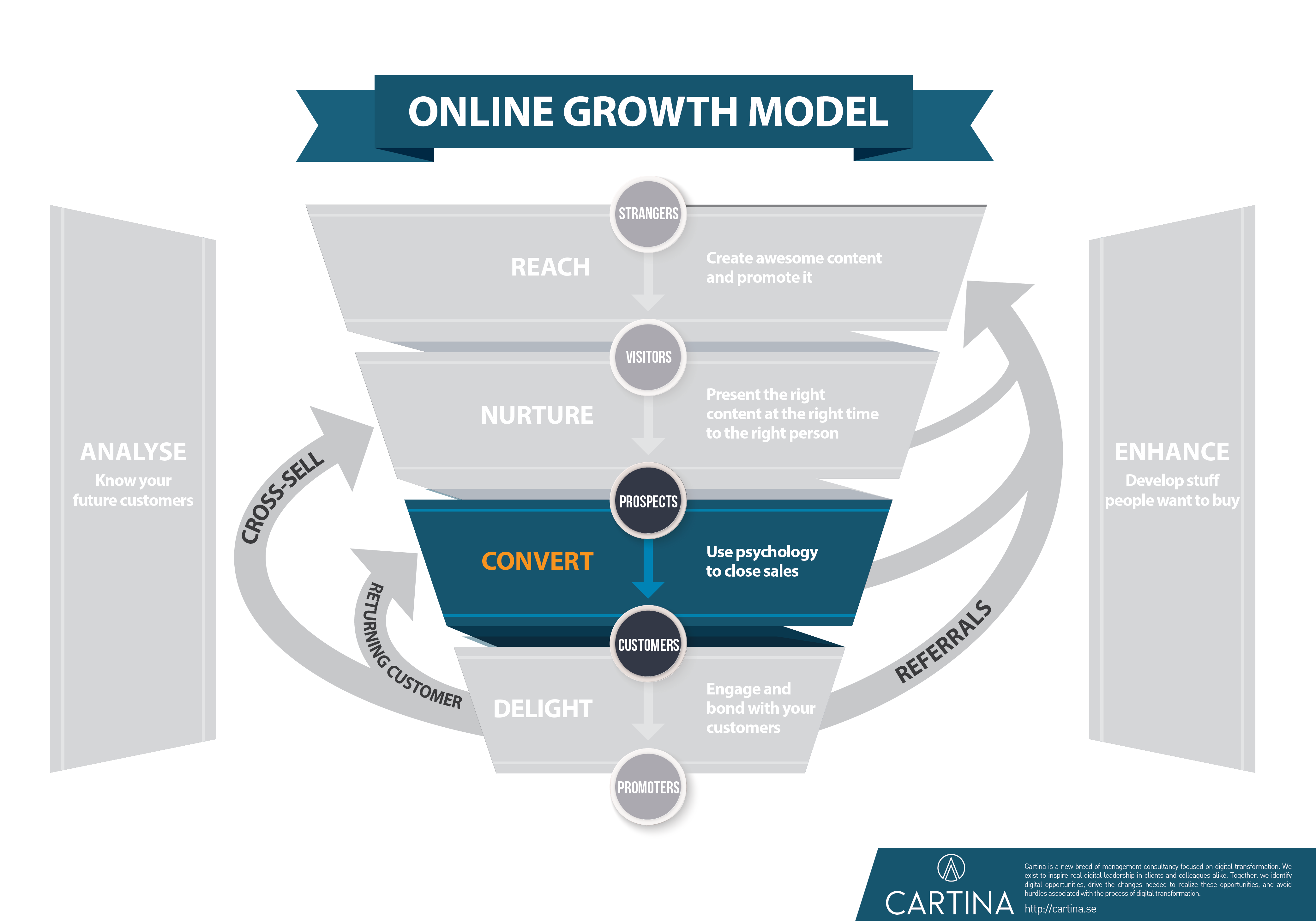
- Conversions can happen at any stage of a customer journey (micro conversions), but here it is meant as the conversion of a potential customer to a paying customer or a user of a free service that you can monetize on later on.
- In the digital growth model, this step is possible to automate by, for example, triggered email sequences, “tripwires,” limited offers, showing benefits, offering several payment options, and so on.
Examples of what you can do:
- In a later blog post I’ll go through some great examples on what you as a food blogger can do to monetize on your traffic. But one example could be if you are selling a cookbook, what can you do to get more readers to buy it. Or if you are offering a weekly meal planning service then your conversion could be to get a visitor to sign up for a free trial and then the next conversion to get them to continue to pay for it.
- Converting can be a lot of different things depending on what your goals are and what you offer. It could be:
- getting people to buy something from you
- getting people to buy something you get affiliate commission on
- getting people to download your app
- getting people to share/comment/pin your recipes
- Once you have moved your contacts through your nurturing sequence it is time to start getting them to convert/buy
- if you have something more expensive or more difficult to sell then it is best to use an email sequence including a bunch of conversion tricks
Things you can do that makes it more likely a person converts (buys):
Which factors below that are relevant for you depends of course on what you are selling. But hopefully it will give you some ideas to optimize for conversion at the buying moment.
- Have an explainer video
- List the benefits
- Show your USP (Unique selling points) against competitors
- Offer something really cheap/easy to buy first – a “Tripwire” (so you already have their payment details and they have lowered the step to buy more from you)
- Have a freemium model or a free trial period
- Money back guarantee
- Right pricing
- Optimized checkout page
- Easy recovery (you don’t want to fill in the same things again if page times out, closes down, etc)
- Minimize the options to choose from
- Have several common payment options
- Have several delivery options
- No/low shipping costs
- Short delivery time
- Limited time discounts
- Count down offer
- Show scarcity
- Live chat
DELIGHT:
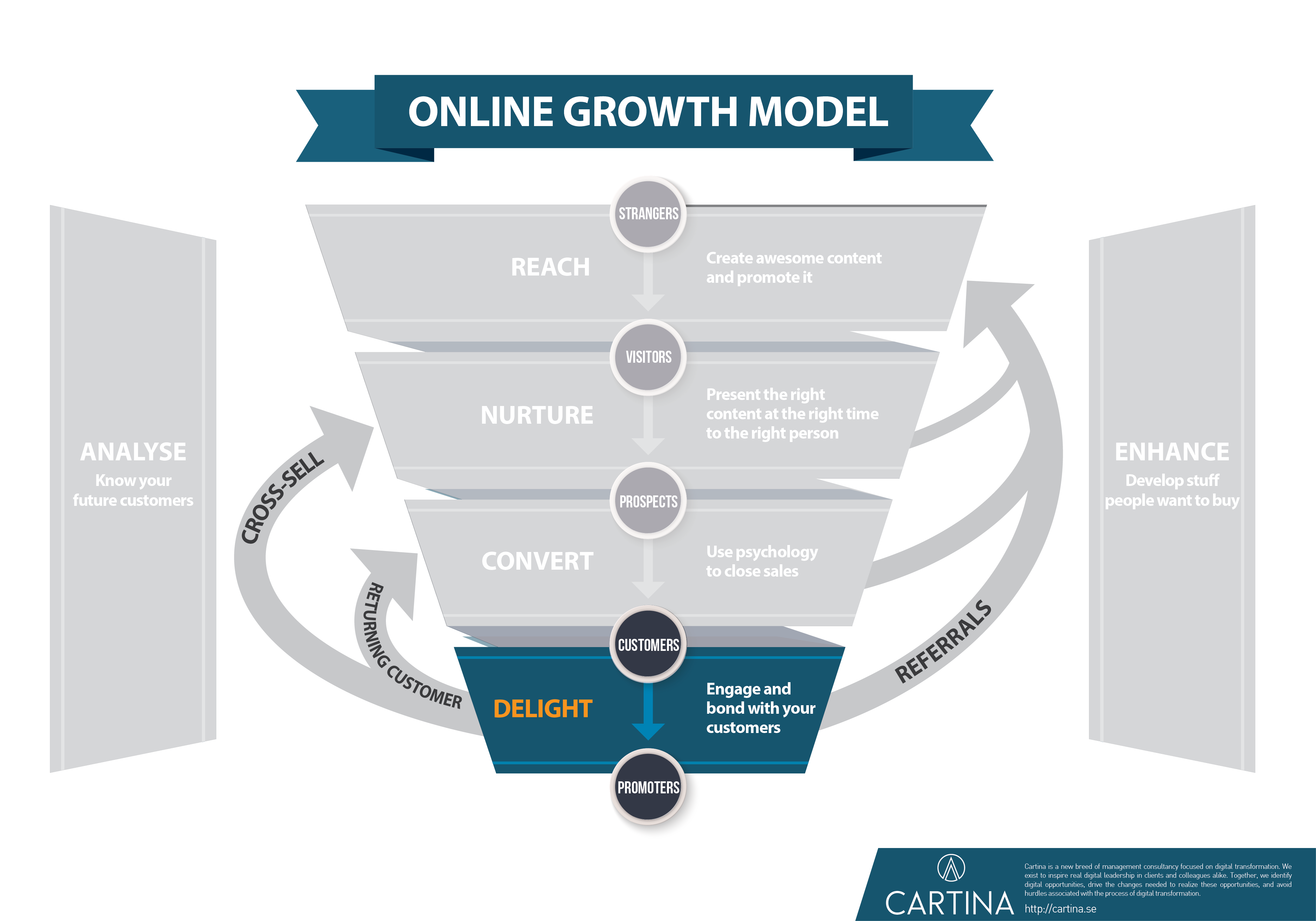
- When the customer has bought the product or service, the focus will shift to making the customer happy with his or her decision. Here we include onboarding to ensure that the customer actually starts to use the product or service.
- Ensure that the customer experience is so good that the customer wants to be a returning customer and, in the end, is so pleased that he or she is willing to share a recommendation with his or her network and friends.
What you can do with onboarding:
- Let us take the example of the weekly meal planning service. Here you need to guide the person to take the steps into actually buying the necessary ingredients, to get them to cook their first meal.
- It will not suffice to just send them the meal plan with recipes and list of ingredients and hope they are motivated enough to start using it.
- You need to nudge them along through an email sequence where you both remind and help them get going. Or it could be a messenger reminder, a prefilled shopping list to print or to add to their digital shopping list. And if you have a big enough number of customers you can use retargeting as another way of reminding them.
What you can do to make them into your ambassadors:
- In the example with the meal planning service it could be that you have linked to a video guide for each recipe and when a user has completed the video they are asked to rate the recipe.
- If they rated it high then they are asked to share a landing page about your meal planning service on their social media. Or ask them for a short testimonial
- If they on the other hand rated it low, then they are asked “I am so sorry to hear that! Please let me know what you did not like and I’ll do my best to adjust future recipes accordingly”
ENHANCE:
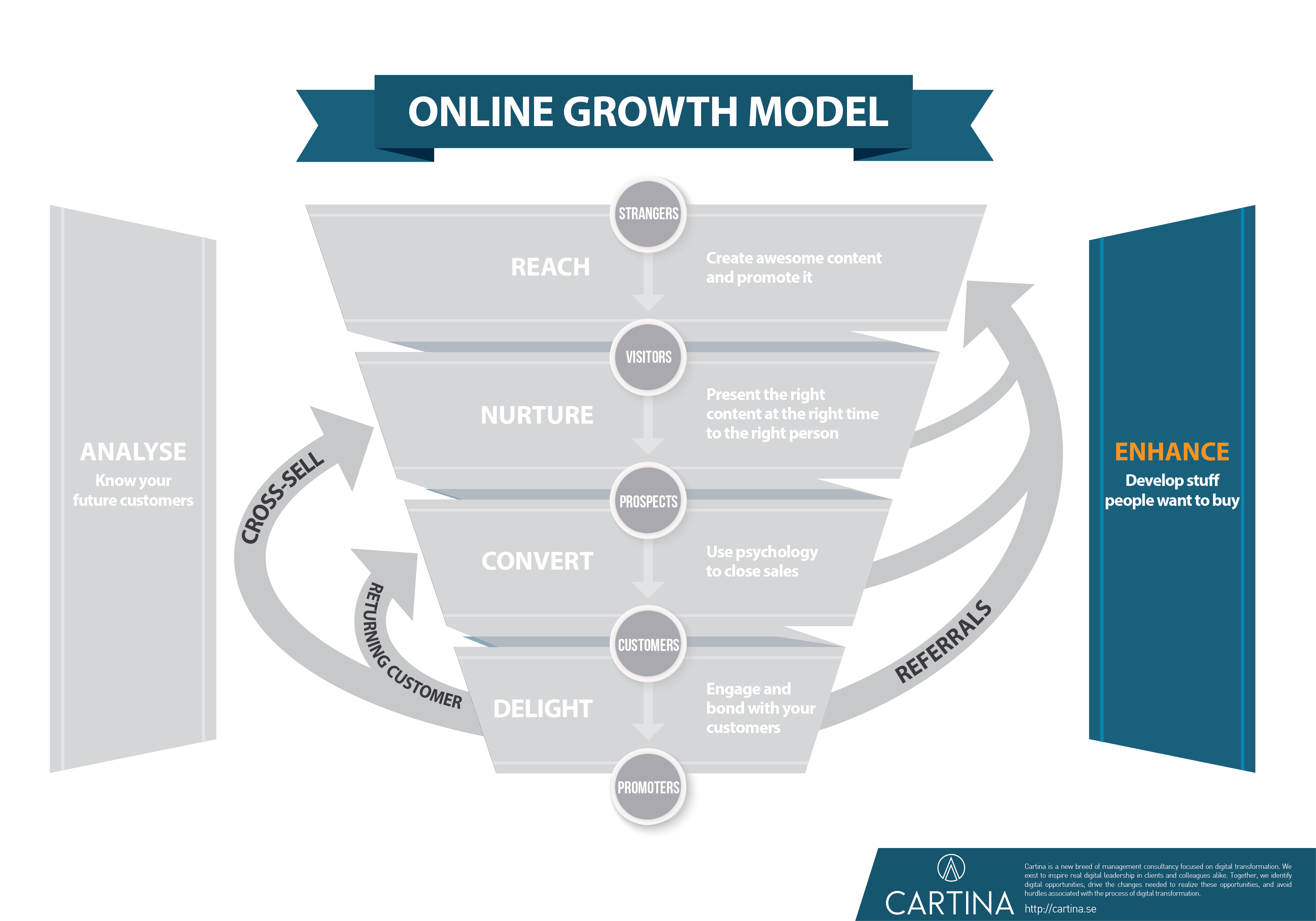
- You can do a ton of marketing and conversion optimization, but if you do not have a product or service that resonates with your target audience, then you will never grow at the rate you want.
- This step is about developing your product or service in an agile way based on the lessons learned throughout the whole customer journey. This information could even lead to creating new products and services.
- In many cases, it is possible to adjust a product or service to support growth tactics.
- In some cases, it could even be the business model that needs to be changed to optimize for growth.
Examples of what you can do:
- In my case I have blog visitors from Sweden, and it would not make sense to offer my app IngredientMatcher only in English to them.
- Or if your visitors are spontaneous people that don’t plan their meals, then it would be much harder to get them to buy your meal planning service.
- It also means that you should gather valuable knowledge about your readers and customers. E.g. having a simple survey pop up asking if they plan their meals in advance or if they choose what to have for dinner on a day by day basis.
- With the meal planning service you should ask your customers which recipes they actually cooked and what they thought of each week
- If you deliver your meal plan by email each week, you can include a call to action to forward it to a friend and for every person that becomes a paying customer you will both get a month for free or something. That is a minor adjustment to your service that will help you grow.
- Or as mentioned in the DELIGHT step to ask for rating of recipes and depending on the answer lead them to either promote you or to send you feedback
- You might learn that a subscription model for your meal planning service is not preferred by your customers. Instead you might consider having sponsors pay to get into the meal plan shopping list and keeping it free for the users.
The online growth model as a whole:
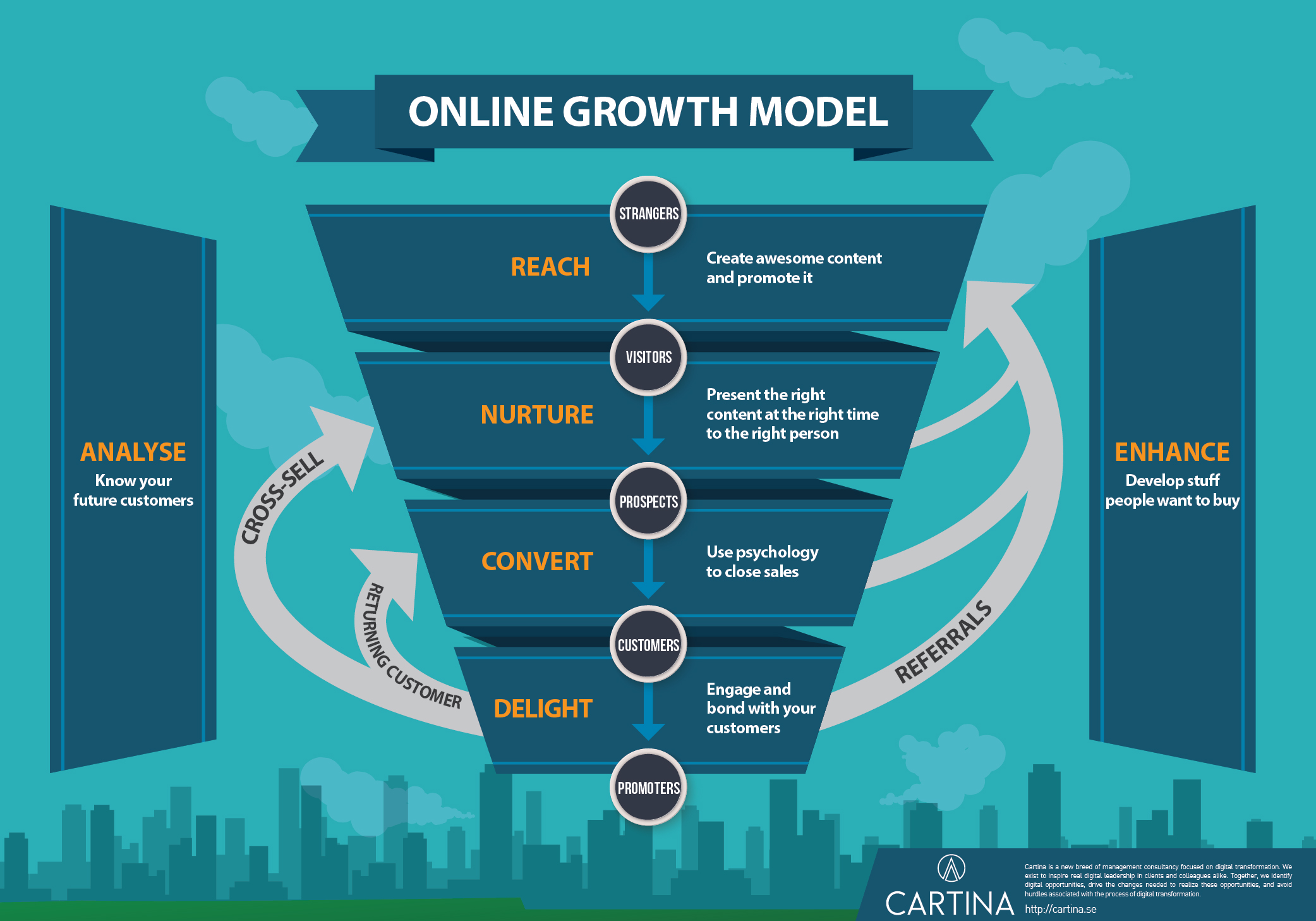
Read more about the Growth model where it was originally published on Cartina
Disclaimers
- It should be mentioned that even though this model is using a funnel and it seems like a person is just moving straight down, it is not meant like that. A person can move in, out, and back again in several of the steps. A person could even move through it in several different channels.
- You could also go through a mini version of the funnel. For example, the customer journey to download a lead magnet could also be viewed as nurturing a person to convert him to giving away his email address as the price for getting access to the lead magnet. After that, you want the person to use the lead magnet and be so delighted with it that he wants to share the link to many more. An even clearer example is when a company has a trial version because then the whole funnel can be used for the trial version even though the customer has not bought anything yet.
- Even though the steps “Analyze” and “Enhance” are visually placed outside of the funnel, they should be thought of as something that is both done before the funnel and simultaneously with all steps of the funnel. The continuous work should be an agile approach where you measure, analyze, brainstorm, prioritize, test, implement, and start over again.
- This model brings up most factors to increase the growth of customers for existing products or services. The model can also be used to evaluate and test if new products or services have growth potential.
- There are a few more strategies a company can use to improve growth that are not included in this model, such as the acquisition of other companies, cooperation with other companies, and going after completely new customer segments or markets with new or adapted products and services.
- Check out more sources for growth in the bullet list below with the 19 traction channels from Traction by Gabriel Weinberg and Justin Mares
Traction Channels for Growth
- Targeting Blogs/Influencers
- Team up with other food bloggers to get the word out to a bigger audience. Perhaps you can find other food bloggers that offers someting complimentary to what you are trying to sell and you can join forces in sending to each other
- Create roundups as a way to send some link love and traffic to each other
- Publicity
- Try with local papers or grocery chains when you are starting out
- If you want a better chance at being featured in a paper / magazine / TV then I suggest you start with identifying most relevant reporters and see how you can help them first before you try to get a favor from them
- Unconventional PR (not included)
- Search Engine Marketing
- Paying for AdWords in Google (this is usually a more expensive way than social ads, but could be relevant if people are searching for a solution to what you offer)
- Social and Display Ads
- Advertising on different social media where the most relevant for food bloggers are Pinterest, Instagram and Facebook.
- This is usually not used to promote your free content but rather your paid services. However, if you have a post that are getting some initial traction with likes, pins, comments, shares then it can very well be worth some money to make it more viral. After all, you have spent time and money on creating awesome content, then spending a little money on the posts with highest potential should be a no brainer.
- Use retargeting to get better results out of the money you spend
- Offline Ads (not included)
- Search Engine Optimization
- As mentioned earlier, it will be a separate post about this
- Content Marketing
- Well, this is basically what a food blog is all about 🙂 Creating content and using that to drive traffic to your site
- Email Marketing
- Everything around using email to your list. See more in the chapter around Nurture
- Viral Marketing
- Setting up your content / service / product in a way to get readers/users to share it with their friends & network creating a viral effect when they in turn also share it.
- Engineering as Marketing
- Creating small applications / plugins that you give away as a way to get leads
- Business Development (partly included)
- Sales (partly included)
- Affiliate Programs
- Get others to promote you in exchange for a small cut on every customer they send your way
- Many of you are probably doing this to other way around with the Amazon affiliate program (Amazon associates program)
- Existing Platforms
- Platforms are Pinterest, Facebook, Yummly where there is already an audience to get in front of
- Trade Shows (not included)
- Offline Events (not included)
- Speaking Engagements (not included)
- Community Building
- A great example is of course the food blogger pro community
- But lets say your niche is pressure cooking, and you make money from affiliate sales of instant pots and other kitchen appliances. Then a facebook group like Jill from This Old Gal created is probably super valuable in sending her traffic
Different Channels for Growth
Another way of organizing different channels for Growth, from the book Hacking Growth by Sean Ellis & Morgan Brown:
Viral / Word of Mouth
- Social media
- Embeddable widgets
- Friend referral program
- Online video
- Community engagement
- Contests / Giveaways
- Platform integrations
- Crowdfunding
- Games / Quizzes
Organic
- Search Engine Optimization (SEO)
- Public relations & Speaking
- Content Marketing
- App Store Optimization (ASO)
- Free tools
- Email marketing
- Community building
- Strategic partnerships
- Contributed articles
- Website merchandising
Paid
- Offline ads
- Online ads
- Affiliate advertising
- Influencer campaigns
- Radio
- Retargeting
- Ad networks
- Sponsorships
- Native content ads
Are you interested to learn more examples, tactics and strategies to use in each part of the model for your food blog? Just send me an email and I can offer you some free consultation
Leave a Reply